Vivonio Furniture Group Bundle
How Does Vivonio Furniture Group Conquer the Competitive European Market?
In a European furniture market projected to reach €136.3 billion by 2025, Vivonio Furniture Group's sales and marketing strategies are crucial for success. This analysis explores how Vivonio, through strategic acquisitions and a diverse brand portfolio, navigates this dynamic landscape. Understanding their approach is key to grasping the evolving tactics within the furniture industry.
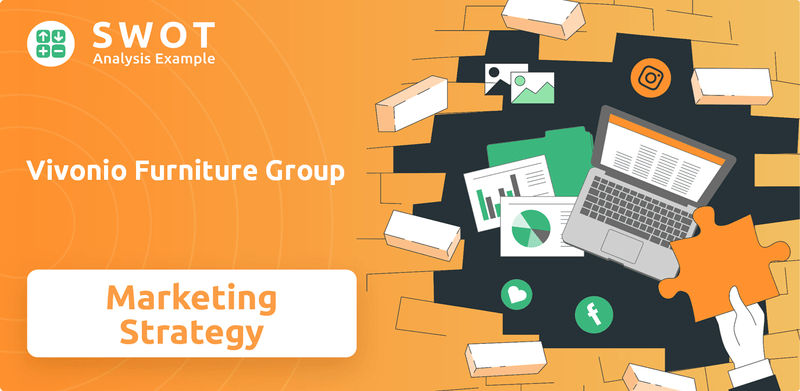
This exploration of Vivonio Furniture Group's sales approach will uncover how they leverage various sales channels and marketing tactics to build brand awareness and drive sales in the competitive furniture industry. Learn about their Vivonio Furniture Group SWOT Analysis, target audience analysis, and successful marketing campaigns. We'll also examine how Vivonio builds brand awareness and its customer relationship management in sales, providing insights into their competitive advantage.
How Does Vivonio Furniture Group Reach Its Customers?
The sales strategy of Vivonio Furniture Group centers on a multifaceted approach, utilizing both online and offline channels to reach its target customers. The company's primary focus is on the mass market segment, where it employs a combination of direct sales, wholesale partnerships, and specialized retail channels to maximize its market presence. This integrated strategy allows Vivonio to cater to a diverse customer base and maintain a strong foothold in the competitive furniture industry.
Vivonio's sales channels include direct sales to major furniture retailers across Germany and Europe, as well as collaborations with corporate clients. A significant portion of its sales comes from its subsidiary, MAJA, which is a major supplier to IKEA. This partnership highlights the importance of wholesale and B2B sales in Vivonio's overall strategy. Additionally, the company's portfolio includes specialized retail channels, such as KA Interiør, which distributes its products through kitchen retailers, DIY stores, and real estate projects.
The evolution of Vivonio's sales channels reflects a strategic shift towards strengthening its position in the European furniture market, which is projected to reach €136.3 billion by 2025. While specific details on Vivonio's direct e-commerce platforms are not readily available, the broader furniture market is experiencing significant growth in online sales. This trend underscores the importance of digital adoption and omnichannel integration for furniture companies like Vivonio. To learn more, explore the Owners & Shareholders of Vivonio Furniture Group.
Vivonio's sales strategy includes direct sales to large furniture retailers and corporate clients. They have a significant wholesale component, particularly through their subsidiary, MAJA, which supplies products to IKEA. This channel is crucial for high-volume sales and market penetration.
Vivonio utilizes specialized retail channels through its portfolio companies, such as KA Interiør. These channels include kitchen retailers, DIY stores, and real estate projects. This approach allows Vivonio to target niche segments and custom-built solutions.
The furniture industry is seeing significant growth in online sales, with e-commerce accounting for approximately 30% of total furniture sales in 2024. This trend emphasizes the importance of digital adoption and omnichannel integration for companies like Vivonio. While specific details on Vivonio's direct e-commerce platforms are not readily available, the broader market trends suggest a growing emphasis on online sales.
The European furniture market is projected to reach €136.3 billion by 2025. This growth indicates a favorable environment for companies like Vivonio to expand their sales and marketing efforts. The company's strategic approach to sales channels is designed to capitalize on this market expansion.
Vivonio’s sales strategy is built on a mix of direct sales, wholesale partnerships, and specialized retail channels. The company leverages its relationships with major retailers and corporate clients while also tapping into niche markets through its subsidiaries. Digital adoption and omnichannel integration are becoming increasingly important in the furniture industry.
- Focus on both online and offline channels.
- Leverage wholesale partnerships for high-volume sales.
- Target niche markets through specialized retail.
- Adapt to the growing importance of e-commerce.
Vivonio Furniture Group SWOT Analysis
- Complete SWOT Breakdown
- Fully Customizable
- Editable in Excel & Word
- Professional Formatting
- Investor-Ready Format
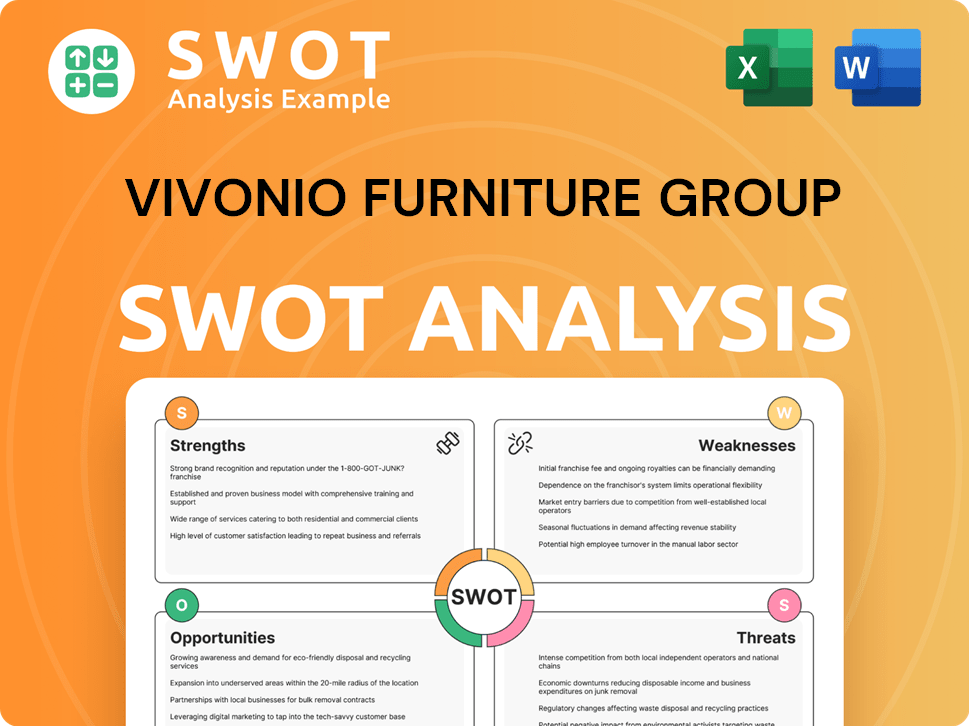
What Marketing Tactics Does Vivonio Furniture Group Use?
The marketing tactics employed by Vivonio Furniture Group, through its various subsidiaries, are designed to boost brand recognition, generate leads, and drive sales within the competitive mass-market furniture sector. The company's strategy leverages its diverse brand portfolio to cater to a wide array of consumer preferences. While specific details about Vivonio's overarching marketing campaigns are limited, the furniture industry's marketing strategies offer insights into the approaches likely used.
In the furniture industry, marketing strategies commonly integrate both traditional and digital methods. Traditional advertising, such as television, radio, and print media, remains effective for reaching potential customers. Digital marketing includes content marketing, SEO, paid advertising, email marketing, influencer partnerships, and social media engagement to build awareness and connect with consumers. The focus is on building relationships and cultivating a following by engaging users with content that resonates with their values, fostering brand identification.
Given the increasing demand for sustainable and multifunctional furniture, Vivonio's marketing efforts would likely highlight these aspects. The global green furniture market is projected to reach $68.6 billion by 2025, and the multifunctional furniture market is expected to reach $45 billion by 2025. Moreover, the industry is seeing a rise in data-driven marketing, customer segmentation, and personalization. Innovative marketing ideas for furniture businesses also include virtual room design tools and augmented reality (AR), with AR users being eight times more likely to convert. For more context, you can read about the Brief History of Vivonio Furniture Group.
Traditional advertising methods like TV, radio, and print are still used to reach a broad audience. These channels help in creating initial brand awareness and reaching demographics that may not be as active online.
Digital marketing strategies are crucial, including content marketing, SEO, and paid advertising. These tactics drive traffic to online platforms and increase visibility in search results.
Social media is used to build relationships with customers by sharing content that aligns with their values. This approach fosters brand loyalty and encourages engagement.
Content marketing involves creating valuable content to attract and engage the target audience. This includes blog posts, videos, and infographics that provide information about furniture and design.
SEO is employed to improve online visibility by optimizing website content and structure. This helps in ranking higher in search engine results, making it easier for potential customers to find the brand.
Collaborating with influencers in the home decor and design space helps in reaching a wider audience. Influencers can showcase products and provide authentic reviews, boosting brand credibility.
The furniture industry is increasingly focused on sustainability and multifunctional designs. Data-driven marketing and personalization are also gaining importance. AR tools are becoming more prevalent, with AR users showing higher conversion rates.
- Sustainable Furniture: The green furniture market is expected to reach $68.6 billion by 2025.
- Multifunctional Furniture: The multifunctional furniture market is projected to reach $45 billion by 2025.
- Data-Driven Marketing: Using data to understand customer preferences and tailor marketing efforts.
- Augmented Reality (AR): AR tools are used for virtual room design, with AR users being eight times more likely to convert.
Vivonio Furniture Group PESTLE Analysis
- Covers All 6 PESTLE Categories
- No Research Needed – Save Hours of Work
- Built by Experts, Trusted by Consultants
- Instant Download, Ready to Use
- 100% Editable, Fully Customizable
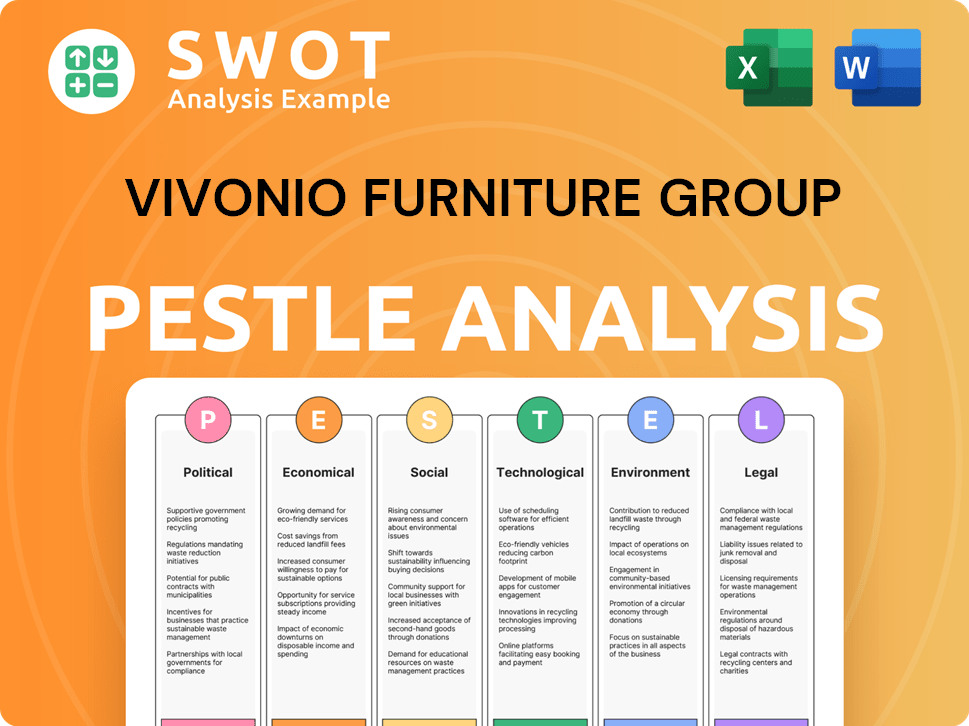
How Is Vivonio Furniture Group Positioned in the Market?
The Vivonio Furniture Group strategically positions itself as a key player in the European furniture market. This is achieved through a diverse brand portfolio that targets various segments within the mass market. Their approach involves acquiring and managing established furniture companies, which allows them to offer a wide range of furniture products for different living areas. This diversification helps to mitigate risks and strengthens their market presence.
The core of Vivonio's brand positioning revolves around providing quality and design within the mass market, especially when competing with companies like IKEA. Subsidiaries like Staud, Noteborn, and KA Interiør showcase the company's commitment to offering products that appeal to different consumer preferences. This includes premium custom products, tailor-made solutions, and designs that reflect current trends, indicating an appeal to a broad target audience seeking both value and contemporary design.
The group's focus on quality is further supported by its established production sites in Germany, Austria, and Denmark. These sites facilitate rigorous quality control and streamlined European logistics, reinforcing the brand's promise of quality. Furthermore, Vivonio emphasizes its commitment to sustainability through its ESG strategy, which is increasingly important to consumers. This approach can enhance brand value and provide a competitive edge in the market.
The brand identity is built upon acquiring and managing established furniture manufacturing and sales companies. This strategy allows for a wide range of furniture offerings. This diversification helps mitigate risks and enhances market resilience, crucial for long-term success in the furniture industry.
Vivonio targets a broad audience seeking quality and design within the mass market. This includes customers looking for both value and contemporary design. The company caters to various segments with its diverse brand portfolio, appealing to different preferences and needs.
Vivonio's competitive advantage lies in its diverse brand portfolio and focus on quality and design. The company's established production sites in Europe ensure rigorous quality control. Their commitment to sustainability through ESG further enhances their market position.
The marketing strategy Vivonio employs focuses on highlighting the quality and design of its products. This is evident through the focus on design and quality. The company's approach involves showcasing its diverse brand portfolio, which caters to various customer segments.
Vivonio distinguishes itself through a strategic furniture alliance, offering a diverse brand portfolio. They emphasize quality and design within the mass market. Their focus on sustainability through ESG further enhances their market position. For more details, check out the Revenue Streams & Business Model of Vivonio Furniture Group.
- Diverse Brand Portfolio: Catering to various segments.
- Quality and Design: Emphasis on standing out in the market.
- European Production: Ensuring quality control and logistics.
- Sustainability: Commitment to eco-friendly practices.
Vivonio Furniture Group Business Model Canvas
- Complete 9-Block Business Model Canvas
- Effortlessly Communicate Your Business Strategy
- Investor-Ready BMC Format
- 100% Editable and Customizable
- Clear and Structured Layout
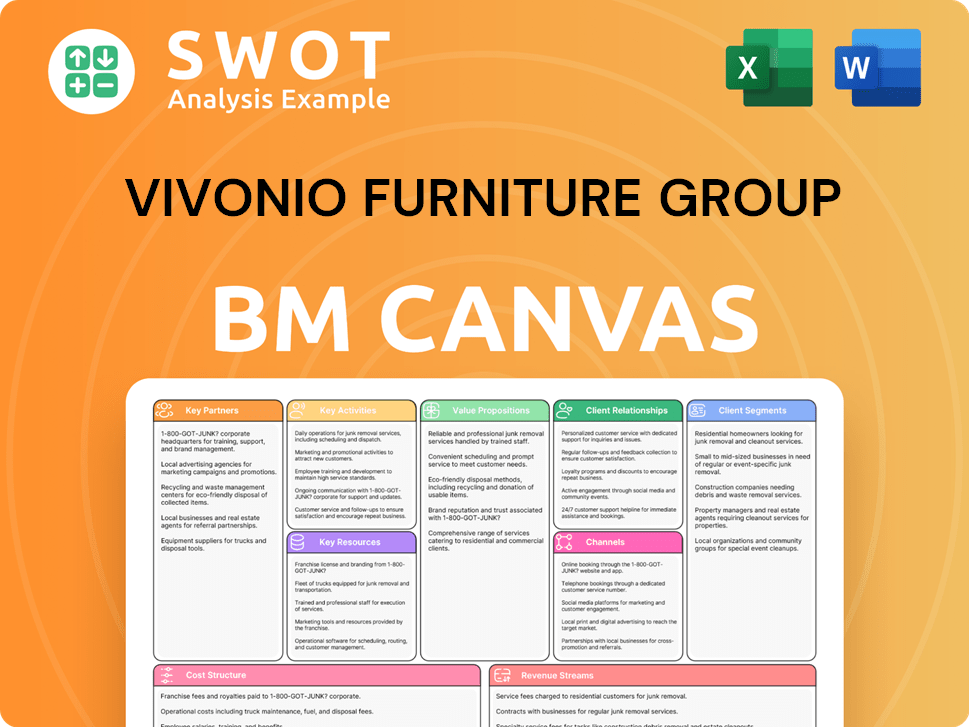
What Are Vivonio Furniture Group’s Most Notable Campaigns?
The sales and marketing strategies of the Vivonio Furniture Group are primarily driven by strategic acquisitions and leveraging its holding company structure. Specific details on consumer-facing marketing campaigns are not extensively publicized. Instead, the company focuses on expanding its market presence through targeted acquisitions and B2B partnerships.
The company's approach involves a mix of organic growth and strategic acquisitions to broaden its product offerings and market reach. This strategy is particularly evident in its expansion within the European market, where it has made several key acquisitions to strengthen its position. These moves are crucial for the company's sales strategy Vivonio, aiming to increase market share and exploit synergies across the group.
A significant aspect of Vivonio's business model involves supplying major furniture retailers like IKEA. This B2B relationship is a core sales strategy Vivonio, focusing on high-volume production and efficient supply chains. This approach allows Vivonio to maintain a consistent presence in the mass market and contribute indirectly to brand visibility.
Vivonio's acquisition of KA Interiør in 2018 is a key example of its growth strategy. This move expanded its portfolio in custom built-in cabinets and strengthened its European market presence. The acquisition aimed to capture further market shares in the growing built-in cabinet and walk-in closet segments.
Vivonio's role as a supplier to major retailers like IKEA represents a crucial sales strategy Vivonio. This strategy focuses on high-volume production and efficient supply chains. Supplying popular product lines to a global retailer like IKEA demonstrates a successful contribution to brand visibility.
The company's focus on maintaining the independent market presence of its subsidiaries while seeking cross-brand synergies suggests an internal 'campaign' for operational efficiency. This internal synergy supports the sales and marketing efforts of its individual brands, leading to cost savings and increased market reach.
Vivonio's approach to furniture industry marketing includes a combination of direct and indirect strategies. By leveraging its B2B relationships and strategic acquisitions, Vivonio aims to achieve significant market penetration. This dual approach allows the company to cover various segments of the furniture market.
Vivonio's marketing strategy Vivonio focuses on strategic acquisitions and B2B partnerships, rather than extensive consumer-facing campaigns. This approach enables the company to expand its market presence and product offerings effectively. The company's success is measured by its ability to integrate acquired businesses and leverage synergies.
- Strategic Acquisitions: Key to expanding the product portfolio and market reach, particularly in Europe.
- B2B Partnerships: Supplying major retailers like IKEA is a core furniture sales tactics, driving high-volume production.
- Internal Synergy: Focus on operational efficiency and shared best practices across subsidiaries.
- Market Penetration: Combination of direct and indirect strategies to cover various furniture market segments.
Vivonio Furniture Group Porter's Five Forces Analysis
- Covers All 5 Competitive Forces in Detail
- Structured for Consultants, Students, and Founders
- 100% Editable in Microsoft Word & Excel
- Instant Digital Download – Use Immediately
- Compatible with Mac & PC – Fully Unlocked
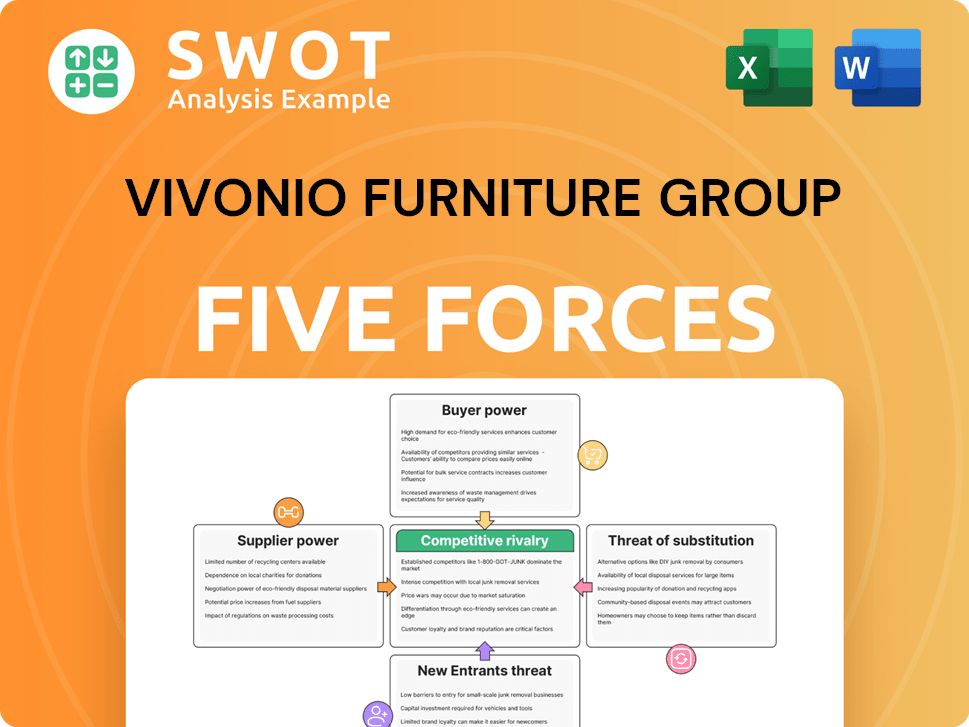
Related Blogs
- What are Mission Vision & Core Values of Vivonio Furniture Group Company?
- What is Competitive Landscape of Vivonio Furniture Group Company?
- What is Growth Strategy and Future Prospects of Vivonio Furniture Group Company?
- How Does Vivonio Furniture Group Company Work?
- What is Brief History of Vivonio Furniture Group Company?
- Who Owns Vivonio Furniture Group Company?
- What is Customer Demographics and Target Market of Vivonio Furniture Group Company?
Disclaimer
All information, articles, and product details provided on this website are for general informational and educational purposes only. We do not claim any ownership over, nor do we intend to infringe upon, any trademarks, copyrights, logos, brand names, or other intellectual property mentioned or depicted on this site. Such intellectual property remains the property of its respective owners, and any references here are made solely for identification or informational purposes, without implying any affiliation, endorsement, or partnership.
We make no representations or warranties, express or implied, regarding the accuracy, completeness, or suitability of any content or products presented. Nothing on this website should be construed as legal, tax, investment, financial, medical, or other professional advice. In addition, no part of this site—including articles or product references—constitutes a solicitation, recommendation, endorsement, advertisement, or offer to buy or sell any securities, franchises, or other financial instruments, particularly in jurisdictions where such activity would be unlawful.
All content is of a general nature and may not address the specific circumstances of any individual or entity. It is not a substitute for professional advice or services. Any actions you take based on the information provided here are strictly at your own risk. You accept full responsibility for any decisions or outcomes arising from your use of this website and agree to release us from any liability in connection with your use of, or reliance upon, the content or products found herein.